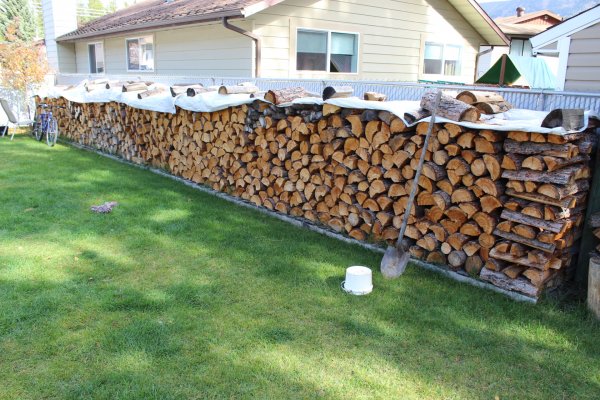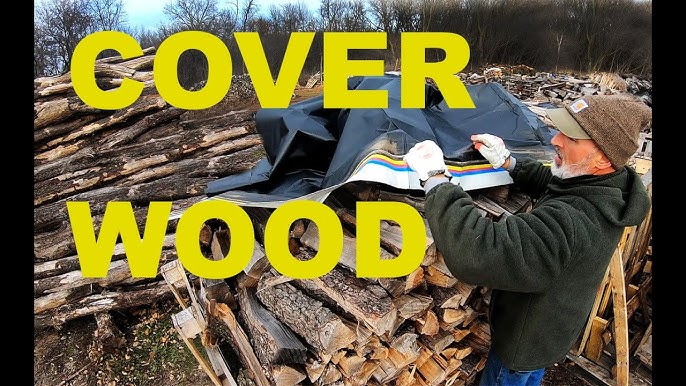Imagine this: You’ve spent your afternoon stacking a neat pile of firewood, ready to keep your home warm during the chilly nights. But now, a question lingers in your mind: should you cover your wood pile?
This isn’t just a matter of aesthetics or neatness; it’s about ensuring that your wood is in the best condition when you need it most. You might wonder if covering it will prevent moisture buildup or if leaving it uncovered will allow for better air circulation.
Each option has its own set of pros and cons, and making the wrong choice could mean soggy, unusable wood when winter hits. Before you decide, let’s explore the implications of both choices so you can make the best decision for your needs and ensure that your wood pile remains a reliable source of warmth. Stay with us as we dive into this important decision!

Credit: www.gardenista.com
Benefits Of Covering Wood Piles
Covering wood piles might seem like an extra chore, but it offers several benefits that can save you time, money, and effort in the long run. Whether you’re preparing for winter or just storing wood for future use, understanding the advantages of covering your wood piles is crucial. Let’s dive into why this simple step can make a big difference for you.
Protection From Moisture
Moisture is the enemy of a good wood pile. When rain or snow hits exposed wood, it can soak deep into the fibers, making it difficult to dry. If you’ve ever tried to start a fire with wet wood, you know the frustration. Covering your wood piles protects them from getting damp, ensuring your logs remain dry and ready for use. A simple tarp or plastic sheet can be your best friend in keeping the wood moisture-free.
Prevention Of Rot And Decay
Rot and decay are not just problems—they’re threats to your wood stockpile. Left uncovered, wood can become a breeding ground for mold and fungi, leading to rot. This not only reduces the amount of usable wood but can also cause structural issues in your stack. By covering your wood piles, you’re taking a proactive step to prevent decay. Imagine the satisfaction of knowing your wood is safe from the elements, ready for burning when you need it.
Improved Burning Efficiency
Dry wood burns better. It’s as simple as that. When you cover your wood piles, you ensure that your logs are dry and thus burn more efficiently. This means less smoke and more heat, making your fires more effective. Have you ever struggled to keep a fire going with damp wood? Covering your wood ensures you won’t face that struggle again. You’ll enjoy cleaner, hotter fires that save time and fuel.
So, do you think your wood pile could use some protection? Covering your wood piles might just be the small change that makes a big impact on your firewood experience.

Credit: firewoodhoardersclub.com
Materials For Covering Wood
Choosing the right materials to cover your wood pile is essential. Proper covering ensures your wood stays dry and burns efficiently. Several options are available that offer protection from moisture and pests.
Tarp Options
Tarps are a popular choice for covering wood piles. They are affordable and easy to use. Available in various sizes, they fit most wood piles. Choose a tarp with UV resistance for durability. Secure it with rope or bungee cords to prevent movement.
Plastic Sheets
Plastic sheets provide effective moisture protection. Lightweight and easy to handle, they cover wood piles efficiently. Clear plastic lets you see the wood without removing the cover. Ensure edges are weighted down to prevent wind displacement.
Wooden Covers
Wooden covers offer a sturdy solution for covering wood piles. Built from spare lumber, they blend well with outdoor settings. They provide excellent protection against rain and snow. Ensure proper ventilation to avoid mold growth.
Placement And Positioning
Covering a wood pile can protect it from rain and snow. This keeps the wood dry and ready to use. Proper placement ensures air circulation, preventing mold growth.
Keeping your wood pile in good condition requires careful consideration of its placement and positioning. A well-positioned wood pile can help keep your wood dry and ready for use, while a poorly placed one may lead to mold and decay. Let’s explore where and how you should position your wood pile for the best results.Optimal Location
Choose a spot that’s convenient for you but also protective for the wood. You want it close to your home to minimize effort during those chilly winter evenings. However, ensure it’s not too close to your house to avoid pests making their way indoors.Look for a location that gets some sunlight to help dry out the wood. A spot that receives morning sun is ideal as it can evaporate any overnight moisture. Make sure it’s not in a low-lying area where water might pool.Elevation For Airflow
Keeping your wood pile elevated is crucial. It allows air to circulate, which helps prevent rot and mildew. Use pallets or bricks to lift the wood off the ground.Imagine trying to dry a wet towel on a flat surface versus hanging it. The same principle applies to your wood pile. Elevation will facilitate airflow and keep your wood in better condition.Avoiding Direct Ground Contact
Direct contact with the ground can cause the wood to absorb moisture, leading to decay. Always ensure there’s a barrier between the wood and the earth.You might think placing wood directly on the ground is stable, but it’s a recipe for soggy logs. Use treated lumber or gravel to create a moisture barrier. Your future self will thank you when you’re enjoying a crackling fire instead of battling damp logs.Have you considered the impact of these small adjustments on the longevity and quality of your wood pile? Taking a few extra steps today can save you trouble tomorrow, ensuring you have dry, burn-ready wood whenever you need it.Common Mistakes
Protecting wood piles from moisture is crucial, yet many overlook proper covering. Exposing wood to rain can lead to mold. This oversight reduces the wood’s lifespan and quality.
When storing firewood, covering it is essential. But many make common mistakes. These errors can lead to damp wood. Or even rot. Understanding these pitfalls ensures your wood remains dry and ready to burn. Let’s explore these mistakes.Over-covering Issues
Covering wood piles too much causes problems. It traps moisture underneath. This can make the wood damp. Damp wood doesn’t burn well. Avoid using thick tarps or plastic sheets. These materials don’t allow air to circulate. Instead, use breathable covers. This helps moisture escape.Ignoring Ventilation
Ventilation is crucial for wood piles. Many forget this. Without airflow, moisture lingers. It can lead to mold or decay. Stack wood loosely. Leave gaps for air movement. Place the pile in an open area. This helps natural air circulation. Good ventilation keeps wood dry and ready.Improper Securing
Securing the cover is vital. Many do it wrong. Loose covers blow away in wind. This exposes wood to rain. Use weights or ties to secure the cover. Ensure it’s snug but not tight. A well-secured cover protects the wood. It stays dry and usable longer.Seasonal Considerations
Covering your wood pile can be crucial, depending on the season. Different weather conditions demand unique approaches to ensure your wood remains dry, usable, and in great condition. Understanding how seasonal shifts impact your wood pile can save you time, effort, and keep your fireplace roaring efficiently.
Winter Protection
Winter brings moisture and snow, which can seep into your wood pile, making it damp and ineffective for burning. Consider using a tarp or a wooden shed to keep your wood dry. You might have experienced the frustration of trying to light a soggy log on a cold winter night. Protecting your wood from snow and rain not only ensures it burns well but also keeps your home warm.
Summer Exposure
Summer’s heat can dry out your wood pile, but direct sunlight can also cause cracking. You should aim for a balance between exposure and protection. Have you ever noticed how wood left in the sun becomes brittle? Position your wood pile in a shaded area to prevent over-drying. It’s about maintaining the right amount of exposure to keep your wood in optimal condition.
Adjusting For Weather Changes
Weather is unpredictable, and your wood pile needs to adapt. Are you prepared for sudden shifts in weather? Maybe a rainstorm appears unexpectedly. Keep an eye on the forecast and adjust your wood covering accordingly. Flexibility in your approach will ensure your wood remains usable regardless of what Mother Nature throws your way.
Think about your own experiences with seasonal wood management. How did you protect your wood last winter? What adjustments did you make during the scorching summer days? Your strategy can evolve with each season, ensuring your fireplace stays a reliable source of warmth and comfort.
Environmental Impact
Covering a wood pile can have significant environmental impacts. The choice of materials and methods can affect sustainability and ecological health. Understanding these effects helps in making informed decisions. Let’s explore how sustainability, eco-friendly practices, and long-term effects play a role.
Sustainability Of Materials
Choosing sustainable materials for covering wood piles is crucial. Natural fabrics or recycled tarps work well. These options reduce the demand for new resources. Avoiding plastics can minimize pollution. Using sustainable materials supports environmental health.
Eco-friendly Practices
Eco-friendly practices can lessen the impact on the environment. Using local materials reduces the carbon footprint. Opt for reusable covers instead of single-use items. Proper disposal of old coverings is also important. These actions can protect the ecosystem.
Long-term Effects
Consider the long-term effects of covering wood piles. Proper covering prevents wood decay and waste. This extends the lifespan of the wood. It reduces the need for frequent replacements. A well-maintained wood pile means less deforestation. This practice supports sustainable forestry.

Credit: www.youtube.com
Frequently Asked Questions
Why Should You Cover A Wood Pile?
Covering keeps wood dry and prevents rot. Wet wood attracts pests. Dry wood burns better and lasts longer.
Does Covering Wood Affect Drying?
Yes, covering affects drying. It protects from rain but allows air circulation. Ensure sides are open for airflow.
What Materials Are Best For Covering Wood?
Tarps, plastic sheets, or metal covers work well. Choose waterproof options. Ensure they cover the top and sides.
Can Wood Piles Attract Insects?
Yes, wood piles can attract insects. Moisture increases risk. Covering helps reduce moisture and insect attraction.
Should Wood Piles Be Covered In Summer?
Yes, even in summer. Rain and humidity can affect wood. Covering helps maintain dryness and quality.
Conclusion
Covering your wood pile offers great benefits. It keeps wood dry and ready. Protects it from rain and snow. Also, prevents rot and pests. Choose breathable covers for best results. They allow air flow. This reduces mold growth. Stack wood properly.
Ensure stability and even drying. Regularly check your wood pile. Adjust covers as needed. This ensures maximum efficiency. Covered wood burns better. It’s safer and more efficient. So, consider covering your wood pile. It’s a simple step. Yet, it makes a big difference.
Your fireplace will thank you.
